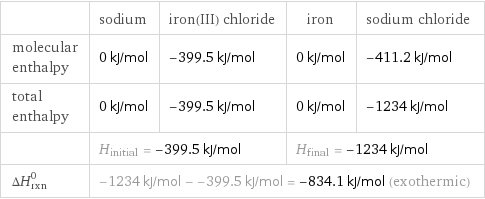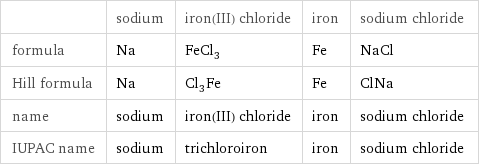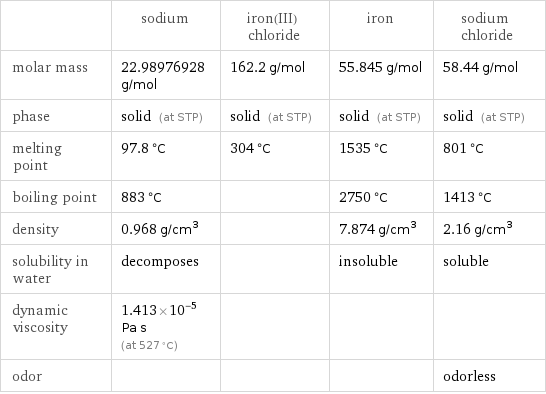Input interpretation

Na sodium + FeCl_3 iron(III) chloride ⟶ Fe iron + NaCl sodium chloride
Balanced equation

Balance the chemical equation algebraically: Na + FeCl_3 ⟶ Fe + NaCl Add stoichiometric coefficients, c_i, to the reactants and products: c_1 Na + c_2 FeCl_3 ⟶ c_3 Fe + c_4 NaCl Set the number of atoms in the reactants equal to the number of atoms in the products for Na, Cl and Fe: Na: | c_1 = c_4 Cl: | 3 c_2 = c_4 Fe: | c_2 = c_3 Since the coefficients are relative quantities and underdetermined, choose a coefficient to set arbitrarily. To keep the coefficients small, the arbitrary value is ordinarily one. For instance, set c_2 = 1 and solve the system of equations for the remaining coefficients: c_1 = 3 c_2 = 1 c_3 = 1 c_4 = 3 Substitute the coefficients into the chemical reaction to obtain the balanced equation: Answer: | | 3 Na + FeCl_3 ⟶ Fe + 3 NaCl
Structures

+ ⟶ +
Names

sodium + iron(III) chloride ⟶ iron + sodium chloride
Reaction thermodynamics
Enthalpy

| sodium | iron(III) chloride | iron | sodium chloride molecular enthalpy | 0 kJ/mol | -399.5 kJ/mol | 0 kJ/mol | -411.2 kJ/mol total enthalpy | 0 kJ/mol | -399.5 kJ/mol | 0 kJ/mol | -1234 kJ/mol | H_initial = -399.5 kJ/mol | | H_final = -1234 kJ/mol | ΔH_rxn^0 | -1234 kJ/mol - -399.5 kJ/mol = -834.1 kJ/mol (exothermic) | | |
Equilibrium constant
![Construct the equilibrium constant, K, expression for: Na + FeCl_3 ⟶ Fe + NaCl Plan: • Balance the chemical equation. • Determine the stoichiometric numbers. • Assemble the activity expression for each chemical species. • Use the activity expressions to build the equilibrium constant expression. Write the balanced chemical equation: 3 Na + FeCl_3 ⟶ Fe + 3 NaCl Assign stoichiometric numbers, ν_i, using the stoichiometric coefficients, c_i, from the balanced chemical equation in the following manner: ν_i = -c_i for reactants and ν_i = c_i for products: chemical species | c_i | ν_i Na | 3 | -3 FeCl_3 | 1 | -1 Fe | 1 | 1 NaCl | 3 | 3 Assemble the activity expressions accounting for the state of matter and ν_i: chemical species | c_i | ν_i | activity expression Na | 3 | -3 | ([Na])^(-3) FeCl_3 | 1 | -1 | ([FeCl3])^(-1) Fe | 1 | 1 | [Fe] NaCl | 3 | 3 | ([NaCl])^3 The equilibrium constant symbol in the concentration basis is: K_c Mulitply the activity expressions to arrive at the K_c expression: Answer: | | K_c = ([Na])^(-3) ([FeCl3])^(-1) [Fe] ([NaCl])^3 = ([Fe] ([NaCl])^3)/(([Na])^3 [FeCl3])](../image_source/70634d266460acf040614d3739cdad77.png)
Construct the equilibrium constant, K, expression for: Na + FeCl_3 ⟶ Fe + NaCl Plan: • Balance the chemical equation. • Determine the stoichiometric numbers. • Assemble the activity expression for each chemical species. • Use the activity expressions to build the equilibrium constant expression. Write the balanced chemical equation: 3 Na + FeCl_3 ⟶ Fe + 3 NaCl Assign stoichiometric numbers, ν_i, using the stoichiometric coefficients, c_i, from the balanced chemical equation in the following manner: ν_i = -c_i for reactants and ν_i = c_i for products: chemical species | c_i | ν_i Na | 3 | -3 FeCl_3 | 1 | -1 Fe | 1 | 1 NaCl | 3 | 3 Assemble the activity expressions accounting for the state of matter and ν_i: chemical species | c_i | ν_i | activity expression Na | 3 | -3 | ([Na])^(-3) FeCl_3 | 1 | -1 | ([FeCl3])^(-1) Fe | 1 | 1 | [Fe] NaCl | 3 | 3 | ([NaCl])^3 The equilibrium constant symbol in the concentration basis is: K_c Mulitply the activity expressions to arrive at the K_c expression: Answer: | | K_c = ([Na])^(-3) ([FeCl3])^(-1) [Fe] ([NaCl])^3 = ([Fe] ([NaCl])^3)/(([Na])^3 [FeCl3])
Rate of reaction
![Construct the rate of reaction expression for: Na + FeCl_3 ⟶ Fe + NaCl Plan: • Balance the chemical equation. • Determine the stoichiometric numbers. • Assemble the rate term for each chemical species. • Write the rate of reaction expression. Write the balanced chemical equation: 3 Na + FeCl_3 ⟶ Fe + 3 NaCl Assign stoichiometric numbers, ν_i, using the stoichiometric coefficients, c_i, from the balanced chemical equation in the following manner: ν_i = -c_i for reactants and ν_i = c_i for products: chemical species | c_i | ν_i Na | 3 | -3 FeCl_3 | 1 | -1 Fe | 1 | 1 NaCl | 3 | 3 The rate term for each chemical species, B_i, is 1/ν_i(Δ[B_i])/(Δt) where [B_i] is the amount concentration and t is time: chemical species | c_i | ν_i | rate term Na | 3 | -3 | -1/3 (Δ[Na])/(Δt) FeCl_3 | 1 | -1 | -(Δ[FeCl3])/(Δt) Fe | 1 | 1 | (Δ[Fe])/(Δt) NaCl | 3 | 3 | 1/3 (Δ[NaCl])/(Δt) (for infinitesimal rate of change, replace Δ with d) Set the rate terms equal to each other to arrive at the rate expression: Answer: | | rate = -1/3 (Δ[Na])/(Δt) = -(Δ[FeCl3])/(Δt) = (Δ[Fe])/(Δt) = 1/3 (Δ[NaCl])/(Δt) (assuming constant volume and no accumulation of intermediates or side products)](../image_source/ed5b82cb650e5d93af891c9efe6bcc14.png)
Construct the rate of reaction expression for: Na + FeCl_3 ⟶ Fe + NaCl Plan: • Balance the chemical equation. • Determine the stoichiometric numbers. • Assemble the rate term for each chemical species. • Write the rate of reaction expression. Write the balanced chemical equation: 3 Na + FeCl_3 ⟶ Fe + 3 NaCl Assign stoichiometric numbers, ν_i, using the stoichiometric coefficients, c_i, from the balanced chemical equation in the following manner: ν_i = -c_i for reactants and ν_i = c_i for products: chemical species | c_i | ν_i Na | 3 | -3 FeCl_3 | 1 | -1 Fe | 1 | 1 NaCl | 3 | 3 The rate term for each chemical species, B_i, is 1/ν_i(Δ[B_i])/(Δt) where [B_i] is the amount concentration and t is time: chemical species | c_i | ν_i | rate term Na | 3 | -3 | -1/3 (Δ[Na])/(Δt) FeCl_3 | 1 | -1 | -(Δ[FeCl3])/(Δt) Fe | 1 | 1 | (Δ[Fe])/(Δt) NaCl | 3 | 3 | 1/3 (Δ[NaCl])/(Δt) (for infinitesimal rate of change, replace Δ with d) Set the rate terms equal to each other to arrive at the rate expression: Answer: | | rate = -1/3 (Δ[Na])/(Δt) = -(Δ[FeCl3])/(Δt) = (Δ[Fe])/(Δt) = 1/3 (Δ[NaCl])/(Δt) (assuming constant volume and no accumulation of intermediates or side products)
Chemical names and formulas

| sodium | iron(III) chloride | iron | sodium chloride formula | Na | FeCl_3 | Fe | NaCl Hill formula | Na | Cl_3Fe | Fe | ClNa name | sodium | iron(III) chloride | iron | sodium chloride IUPAC name | sodium | trichloroiron | iron | sodium chloride
Substance properties

| sodium | iron(III) chloride | iron | sodium chloride molar mass | 22.98976928 g/mol | 162.2 g/mol | 55.845 g/mol | 58.44 g/mol phase | solid (at STP) | solid (at STP) | solid (at STP) | solid (at STP) melting point | 97.8 °C | 304 °C | 1535 °C | 801 °C boiling point | 883 °C | | 2750 °C | 1413 °C density | 0.968 g/cm^3 | | 7.874 g/cm^3 | 2.16 g/cm^3 solubility in water | decomposes | | insoluble | soluble dynamic viscosity | 1.413×10^-5 Pa s (at 527 °C) | | | odor | | | | odorless
Units
